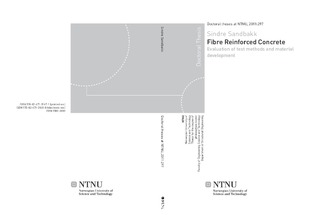| dc.contributor.author | Sandbakk, Sindre | nb_NO |
| dc.date.accessioned | 2014-12-19T11:59:16Z | |
| dc.date.available | 2014-12-19T11:59:16Z | |
| dc.date.created | 2012-01-13 | nb_NO |
| dc.date.issued | 2011 | nb_NO |
| dc.identifier | 477607 | nb_NO |
| dc.identifier.isbn | 978-82-471-3167-1 (printed ver.) | nb_NO |
| dc.identifier.isbn | 978-82-471-3168-8 (electronic ver.) | nb_NO |
| dc.identifier.uri | http://hdl.handle.net/11250/236730 | |
| dc.description.abstract | Concrete is a structural material with excellent properties when subjected to compression, butthe abilities to resist tensile stresses are rather poor. The concrete’s tensile zone is normallyreinforced with large continuous steel bars, a combination which ensures an excellentconstruction material. Placing the re-bars generates many man-hours, which means that the reinforcement work accounts for a considerable part of the total concrete cost. An alternative to the conventional re-bars is fibre reinforced concrete.
Fibre reinforced concrete is concrete reinforced with small randomly distributed discontinuous fibres instead of large unidirectional continuous steel bars. In cases where thestrength and ductility of fibre reinforced concrete is sufficient with regard to the actions, fibrereinforced concrete can be an adequate and cheaper alternative to conventionally reinforced concrete. If fibres are used together with conventional re-bars, both the total load carryingcapacity and the stiffness of the structure will increase, and the crack widths will decrease.
One working hypothesis in the present thesis has been that the behaviour of fibre reinforced concrete can be uniquely described by the fibre slip, and an objective has been to investigate whether this hypothesis is correct or not. Due to the fact that the maximum fibre stress achieved during pull-out test is considerably less than the fracture stress for most fibre types,it is reasonable to assume that the fibres’ pull-out length in a real structure is identical with the crack width, because the fibres will simply loosen at the weakest side of a crack. Based on alarge number of experiments, and some simplified models which relate the experimental results to crack openings, it seems like the working hypothesis is correct.
A theoretical relation between the results from energy absorption test found by two differenttest codes is established. This relation is based on the above mentioned working hypothesis,and it is shown that the theoretical relation corresponds well to an empirical relation found in the literature.
A second objective has been to show that fibre reinforcement actually has sufficient strength and ductility to be used as a replacement to conventional re-bars in some types of concretestructures. A concrete called ductile high tensile strength all round concrete is developed, and this concrete shows promising properties with regard to both shear strength, bending strength and ductility.
The last few pages of the present thesis deals with some paradoxes from some of the material models used to describe fibre reinforced concrete from the literature. The experiences from the experimental work, and the analyses of the results, indicate that the fibre efficiency is increased by increasing crack widths until the crack widths reaches a certain level, while most of the models suggest that fibres are most effective at smaller crack widths. | nb_NO |
| dc.language | eng | nb_NO |
| dc.publisher | Norges teknisk-naturvitenskapelige universitet, Fakultet for ingeniørvitenskap og teknologi, Institutt for konstruksjonsteknikk | nb_NO |
| dc.relation.ispartofseries | Doktoravhandlinger ved NTNU, 1503-8181; 2011:297 | nb_NO |
| dc.title | Fibre Reinforced Concrete: Evaluation of test methods and material development | nb_NO |
| dc.type | Doctoral thesis | nb_NO |
| dc.contributor.department | Norges teknisk-naturvitenskapelige universitet, Fakultet for ingeniørvitenskap og teknologi, Institutt for konstruksjonsteknikk | nb_NO |
| dc.description.degree | PhD i konstruksjonsteknikk | nb_NO |
| dc.description.degree | PhD in Structural Engineering | en_GB |
